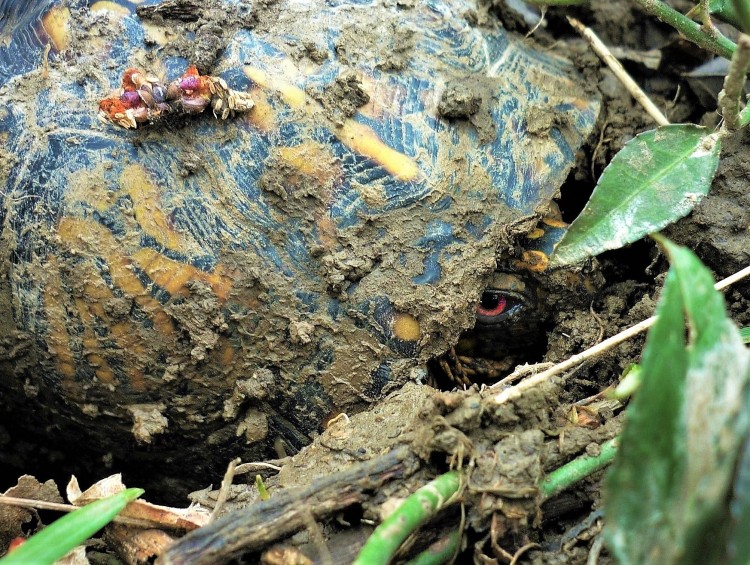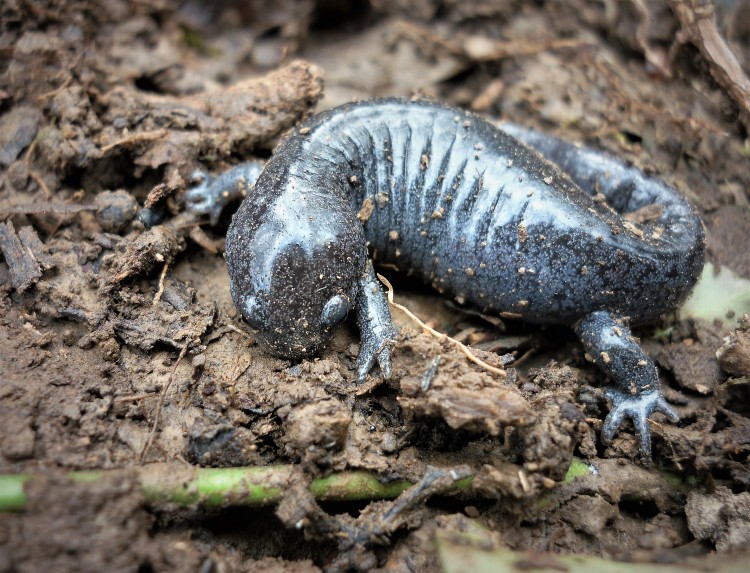
Early spring trilling of frogs is not to be heard in this forest anymore, despite acres of temporary wetlands. But thankfully other herps have managed to survive the various uses this land has been put to, and its increasing isolation from other fragments of habitat. Box turtles find our moist lowland forest has everything they need, and I was lucky enough to witness the very early emergence of this male turtle on a warmish day over a week ago.
All my other records of the first spring Box turtles are in April; as it turns out this fellow was a little too quick to come up, and the following day he dug back down a bit as the temps dropped again.

As you can see from the pic above, it was just chance that I happened to spot him. Though he had the energy to dig out of “brumation” (reptile hibernation), he was still too cold and sluggish to move any further. This behavior is not unusual; brumation in box turtles is something of a process. Cold fall days will send them below ground, only to emerge again when it warms. I have one record of a Boxie up and about on a warm day in December.

You might not think of salamanders when it’s cold, but with late winter’s first warmish rains they head to their breeding ponds. The small spring fed pool above is the only stable breeding site I know of in this forest. Though there’s a lot of water pouring through as runoff, it’s not clean and dries up relatively fast. I’ve been trying to keep it the little pool useful for the sallies with a bit of maintenance. A yearly scooping out of sediment and black walnuts keeps it from reverting to the stinking black muckhole it was years ago.

Though the pool has a lush growth of algae, it’s apparently not a problem and seems to be helpful; when I scooped some out many tiny larvae were hiding in its strands. This pool may be used by at least two species, the Cave Salamander Eurycea lucifuga, and the Streamside Salamander Ambystoma barbouri. Cave Salamander larvae first hatch inside the shallow cave from which the spring flows, and move down into the pool as they mature. These larvae can be seen even in the middle of winter in the pool at the mouth of the spring, since the water temperature fluctuates less here .

The salamander larva above was recently scooped from the pool for observation. Not being an expert, I can’t tell you which species it is. But it could be related to the lovely creature (pic below) that was accidentally uncovered nearby, while planting Spicebush. This Streamside salamander was sheltering under a length of bark tucked up against a fallen trunk; it’s fat chunkiness is typical of the Mole salamanders, genus Ambystoma. The adults are seldom seen because, like moles, they spend most of their lives in underground burrows. Streamside salamanders are part of a complex of closely related species (including the Tiger salamander), and are found in a small range that spans northern Kentucky, and bits of southern Ohio and Indiana.

Mole salamanders have been the subject of some fascinating genetic research that has coined the term “kleptogenesis”. It’s latin for gene-stealing, which is one way to describe the behavior of a 5 million year old Ambystoma lineage that’s all female. This Great Lakes centered population produces offspring that are mostly copies of the mother, but incorporate genetic material from males of three other Ambystoma species (making them polyploid). These unisexual salamanders defy our traditional notion of a species, and researchers suspect it may be the reason this lineage has persisted so long.
A good link for more: https://www.popsci.com/female-salamander-kleptogenesis
Though we like to put life-forms in a species box, successful hybridization is common in nature and is one path to possible new speciation. Coywolf, anyone?
And for my readers in the midwest – HAPPY SPRING! Be sure to feed the birds.

`

Rebecca Minnick
So why are there not frogs? I’ve been listening for them in the preserve and have been puzzled by the absence.Also, super cool info about the streamside salamander!
LikeLike
oneforestfragment
Great question – the land use practices on this site, particularly in the early 20th century included creek channelization, draining of wetlands, and agriculture on the floodplain. Most of the temporary wetlands in the forest are actually situated in the historic creek channel of the South Fork. Though habitat is now likely suitable for frogs, there are no nearby populations to recolonize.
LikeLike
Madison Woods. Or maybe today I'm Ima Erthwitch, my other alter-ego.
Fascinating post. I know we have salamanders here, but I’ve only found one in the 13 years of tromping around the woods. It was black with yellow spots. I did not know they had larvae. I would have just at a quick glance assumed that larvae was a tadpole with legs! I’m very sorry to hear the frogs have disappeared. That seems a very ominous portent. When did they disappear? I’m glad your Forest Fragment has a friend in you.
LikeLike
oneforestfragment
Thanks Madison. You found a Tiger salamander, also in the genus Ambystoma! Seldom seen because they’re underground most of the time. Frogs have been missing from this forest for a long time, which is not surprising because we’re in an urban area – see the post about the creek from 8/19/17 for more info.
LikeLiked by 1 person
sweetgumandpines
Lovely post. That red eye peeking out from under the carapace makes a particularly striking photo. Do you know if the box turtles in your forest fragment are managing to breed successfully? I imagine the surrounding roads must be dangerous for them.
“Kleptogenesis” is my new vocabulary word for the day. After a lifetime of studying biology, there are still so many new things to learn.
LikeLike
oneforestfragment
Thank-you! I know they are breeding and nesting from personal observation – but the # of baby turtles and their survival rate is very hard to determine. Nest predators like raccoons are abundant here, but Boxies are fortunate to be fairly sheltered from roads by a deeply channelized creek and a large park buffer. Decline of Ash trees and invasive plant removal may provide more interior nest sites, rather than on the “edge”where mowers are a danger to female turtles.
Kleptogenesis is a new word for me too!
LikeLiked by 1 person
forestechos
Great info and photos! Would it be possible to reintroduce frogs?
LikeLiked by 1 person
oneforestfragment
Thank-you! Yes, it would be possible to re-introduce frogs but there would likely be bureaucratic hurdles to doing it properly. We actually have a small # of one species, the Grey Tree Frog, which survives in urban areas because it’s mostly arboreal and can breed in unmaintained backyard swimming pools.
LikeLiked by 2 people
Pingback: Salamanders – Sweetgum and Pines